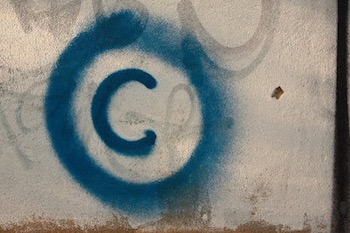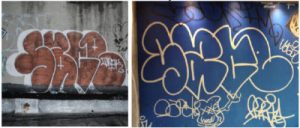
“Large Copyright Graffiti Sign on Cream Colored Wall” by Horia Varlan. Licensed under CC BY 2.0.
American fast food corporation McDonald’s (NYSE:MCD) has been making headlines over the past year for a series of restaurant remodeling, which has met with various levels of consumer approval. By the end of 2015, McDonald’s had completed renovations on about 20 percent of its 14,300 U.S. locations which now feature a series of modernized restaurant styles and decor. Overseas, McDonald’s has adopted an industrial theme for remodeled locations in the United Kingdom, where metal rivet facades and graffiti treatments have met with some skepticism from customers.
Unfortunately, McDonald’s choice to go with a pre-treated graffiti look in some of its restaurants has posed legal challenges along with consumer concerns. On October 3rd, McDonald’s was listed as a defendant in a copyright infringement action filed by Jade Berreau, the administrator of the estate of graffiti artist Dashiell Snow, a former girlfriend of Snow and the mother of his only child. Berreau alleges that graffiti decor used by McDonald’s in the interior of hundreds of its restaurants around the world directly infringes on a “tag,” or graffiti lettering, which was developed and used by Snow and became strongly associated with his work. The case has been filed in the U.S. District Court for the Central District of California (C.D. Cal.).
During his life, Dash Snow cut an interesting and rebellious figure into the art scene of New York City. A member of the de Menil family renowned for its collection of global art, Dash lived a rebellious life in which he became celebrated for creating art with a sense of provocation. Dash passed away in 2009 at the age of 28 after a drug overdose, but not until after he had achieved acclaim and some level of commercial success. As of 2006, at the age of 25, Snow’s top art sale reached $13,000 for an installation with mirror, cinderblocks and chair. Berreau’s filed complaint notes that Snow’s work had previously fetched six figures at auction at such renowned art auction houses as Christie’s and Sotheby’s.
 The complaint focuses on McDonald’s use of graffiti decor which closely approximates a “SACE” tag used by Snow as his graffiti artist pseudonym. The billowy lettering can be found in just about every McDonald’s location where graffiti decor has been used, according to the complaint. Further, not only does the plaintiff allege that Snow’s “SACE” tag is prominently displayed within the decor, it’s also the only part of the decor which can clearly be associated with a graffiti artist. “The remaining graphic elements are comprised of generic anonymous shapes and scribbles,” the complaint reads. “Mr. Snow’s famous work is so prominently placed, it was the only element singled out and spotlighted in media coverage surrounding McDonald’s display campaign.”
The complaint focuses on McDonald’s use of graffiti decor which closely approximates a “SACE” tag used by Snow as his graffiti artist pseudonym. The billowy lettering can be found in just about every McDonald’s location where graffiti decor has been used, according to the complaint. Further, not only does the plaintiff allege that Snow’s “SACE” tag is prominently displayed within the decor, it’s also the only part of the decor which can clearly be associated with a graffiti artist. “The remaining graphic elements are comprised of generic anonymous shapes and scribbles,” the complaint reads. “Mr. Snow’s famous work is so prominently placed, it was the only element singled out and spotlighted in media coverage surrounding McDonald’s display campaign.”
Not only has the use of Snow’s graffiti tag been valuable to McDonald’s marketing efforts, it’s likely one of the last places where Snow would have wanted to see his work displayed. The plaintiff alleges that McDonald’s representatives have acknowledged that displays featuring the “SACE” tag have contributed to a 9 percent increase in sales at those locations. “Defendant’s exploitation of Mr. Snow’s work is all the more unfortunate because the artist carefully avoided any association with corporate culture and mass-market consumerism,” the complaint reads. It goes on to note that Snow never made his work available on the Internet or in retail stores both for artistic reasons and to prevent the value of his work from diminishing. “Nothing is more antithetical to Mr. Snow’s outsider ‘street cred’ than association with corporate consumerism – of which McDonald’s and its marketing are the epitome,” the complaint reads.
This lawsuit was filed after the Snow estate first demanded this past June that McDonald’s remove the artwork from its restaurants, but McDonald’s has allegedly refused to comply. Its refusal to remove the artwork has led the plaintiff to charge that the fast food chain has diminished the value of Snow’s works.
This is not the first time this year that McDonald’s has gotten into a legal flap over the graffiti decor used in its restaurants, despite the Snow estate’s claim that no other works from famous artists have been copied by McDonald’s. This March, Los Angeles-based graffiti artist Eric Rosenbaum filed suit, also in C.D. Cal., for McDonald’s’ misappropriation of a graffiti work consisting of the lettering “NORM” painted around a fire escape in Brooklyn, NY. The artist claimed that he lost work because of the infringement and sought $10 million in damages. In May, Rosenbaum filed a notice of voluntary dismissal of the case.
Berreau’s suit includes six claims for relief against McDonald’s and a series of 10 Doe defendants. Beyond copyright infringement, other claims seek relief for falsification of copyright management information, negligence and unfair competition under terms of the Lanham Act, California business and professions code as well as California common law. The plaintiff seeks damages including the disgorgement of all proceeds related to the infringing activity as well as a court order that McDonald’s immediately take down the offending displays.
The question of whether graffiti art can claim copyright-protected status has been a growing topic of interest in recent years, despite the sense of rebellious counter-culture prevalent in that sector of the artistic scene. In July 2014, Miami-based street David Anasagasti filed a lawsuit against clothing retailer American Eagle which alleged that American Eagle had incorporated a design popularized by Anasagasti, rows of eyes which have been painted to appear half-asleep, into a global advertising campaign for the retailer. The two sides reached a settlement in December 2014 which Anasagasti’s counsel said was mutually acceptable to either side. In August 2014, the fashion company founded by Italian designer Roberto Cavalli was targeted in a copyright infringement suit by artists from San Francisco who claimed that Cavalli had copied a street mural from that city for the designer’s “Graffiti” collection.
In each of these cases, just as in the case brought by the Snow estate, the copying of a graffiti artist’s design was derided as misappropriation of that artist’s “street cred” but these artists’ work portray anti-corporate themes, making the infringement not only financially troublesome but also very offensive to the artists’ sense of their own work. Companies working to rebrand their company with a graffiti style should take care to make sure that the graffiti style itself is original. McDonald’s creating a tag with “MCD” lettering might seem cheesy, but it’s also a much safer choice from a legal standpoint.

![[IPWatchdog Logo]](https://ipwatchdog.com/wp-content/themes/IPWatchdog%20-%202023/assets/images/temp/logo-small@2x.png)

![[Advertisement]](https://ipwatchdog.com/wp-content/uploads/2024/04/Patent-Litigation-Masters-2024-sidebar-early-bird-ends-Apr-21-last-chance-700x500-1.jpg)

![[Advertisement]](https://ipwatchdog.com/wp-content/uploads/2021/12/WEBINAR-336-x-280-px.png)
![[Advertisement]](https://ipwatchdog.com/wp-content/uploads/2021/12/2021-Patent-Practice-on-Demand-recorded-Feb-2021-336-x-280.jpg)
![[Advertisement]](https://ipwatchdog.com/wp-content/uploads/2021/12/Ad-4-The-Invent-Patent-System™.png)







Join the Discussion
2 comments so far.
Eric Berend
November 9, 2016 09:55 am@1., ‘Benny’:
Hilarious. Historically, art has seldom been entirely encapsulated in its expression by other imperatives; particularly mores. As with other sentimental, specious criticisms, your impression of “vandalism” says more about you, than about the so-called ‘offense’ you perceive.
Much of the “vandalism” was performed upon abandoned properties or filthy, poorly maintained subway cars which in net effect, revealed a partial abandonment of the public interest supposedly so harmed. The benefit realized as compared to the dubious degree of harm caused, yielded a net benefit to society.
But, then again, you wouldn’t call the Lascaux (aka “Lausanne”) cave paintings “art”; now, would you, Benny. It was just graffiti, wasn’t it?! D*mn it, they VANDALIZED THOSE CAVES! (/sarcasm/ to those for whom it was not obvious)
http://witcombe.sbc.edu/sacredplaces/lascaux.html
http://www.bradshawfoundation.com/lascaux/
https://en.wikipedia.org/wiki/Lascaux
Benny
November 9, 2016 05:12 amThe article is ambivalent on the distinction – morally, not legally – between vandalism and art.